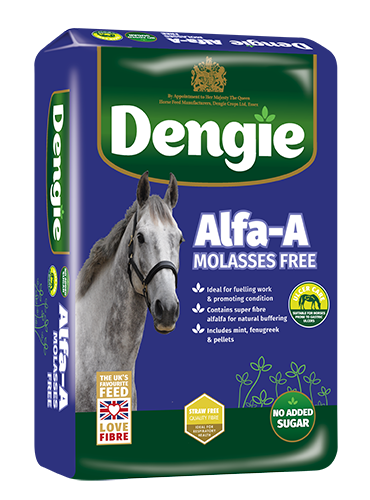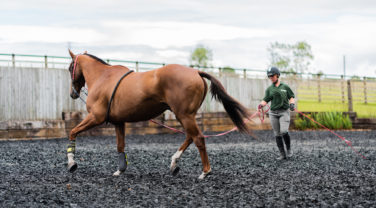Study questions hay net ‘benefits’
Research by a Writtle University College student showing that small-holed hay nets do little to prolong feeding times and even cause frustration in some horses has made the nutrition team at Dengie Horse Feeds question the effectiveness of using them.
“We often advise using this type of net to slow down the rate of forage intake and therefore improve gut health,” said Dengie Senior Nutritionist Katie Williams, “but the findings suggest that horses are too clever by half and suss out how to eat just as quickly after just 10 minutes of using a small-holed net!”
Lily Crockett conducted a 28-day trial between November and December 2013 using seven horses from Writtle College, near Chelmsford, Essex. They were given hay nets of different designs filled with hay. Each net was weighed before the trial and again at 10-minute intervals over a 30-minute period to record how much hay was consumed.
There was found to be no significant difference in the volume of consumption when comparing a large-holed net (1,357g), small-holed net (1,014g), Elim-a-Net (886g) and double-meshed net (843g).
The same was found to apply to the actual rate of intake over the 30 minutes. The large-holed net recorded 45g/min, the small-holed net 34g/min, Elim-a-Net 30g/min and the double-meshed net 28g/min. However, there was a significant difference during the first 10 minutes between the large-holed net and Elim-a-Net, at 53g/min and 29g/min respectively.
The report also pointed out that hay nets did appear to cause frustration in the horses taking part.
“Previous studies have shown that creating multiple feeding stations around the stable provides horses with the opportunity to display more natural feeding behaviour. This may help to slow horses down when feeding because they have to move around more,” said Katie.
“This and Lily’s study really serve to illustrate that short-chopped fibre feeds such as those in Dengie’s Hi-Fi range, given as a bucket feed are perfect for feeding alongside hay to create a number of feed points, slowing down intake and encouraging natural feeding behaviour. Giving a horse access to low-starch, low-sugar fibre feeds on an ad-lib basis is a great way to improve gut health and maintain general wellbeing.”
Lily’s study used the evaluation of past research literature highlighting the need to devise methods of prolonging feeding time and promoting time expenditure similar to that seen in wild horses. Four different types of hay nets were used to see whether they were effective at doing this. Ways in which nets could be used to prolong feed in the management of horses with equine gastric ulcers was also considered.
Although Lily found that there was a significant difference in the amount of hay consumed and the intake rate during the first 10 minutes, this was not the case over the full 30 minutes, so she concluded that horses are able to adapt to different types of net designs.
Double-meshed nets and Elim-a-Nets proved no better than their large-holed counterparts in prolonging feeding time and the frustration they caused could be detrimental to the horse’s welfare.
Horses in a domestic environment are often left without feed for long periods. With reduced opportunity to chew, much less saliva – a natural buffer to acidity – is produced and an empty stomach has nothing with which to soak up the harsh gastric acid.
Theoretically, hay nets such as those of the doubled-meshed or Elim-a-Net variety, if they are capable of reducing the rate of feed intake and prolonging feed time, would give greater chewing time and higher levels of saliva production, and make sure that there is plenty of food to line the stomach for longer periods.
However, the study’s results showed little significant difference in consumption volume or intake between the nets, illustrating that they were of no particular benefit for horses suffering from gastric ulcers.



